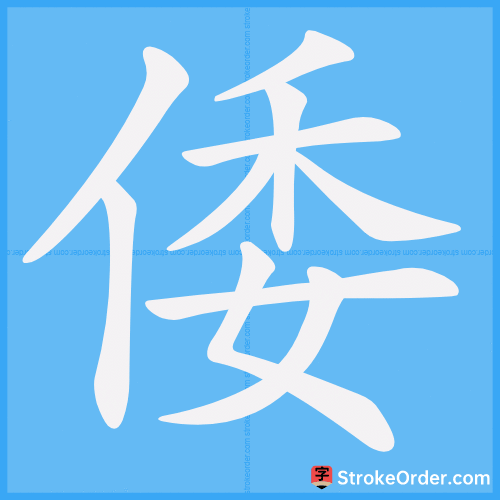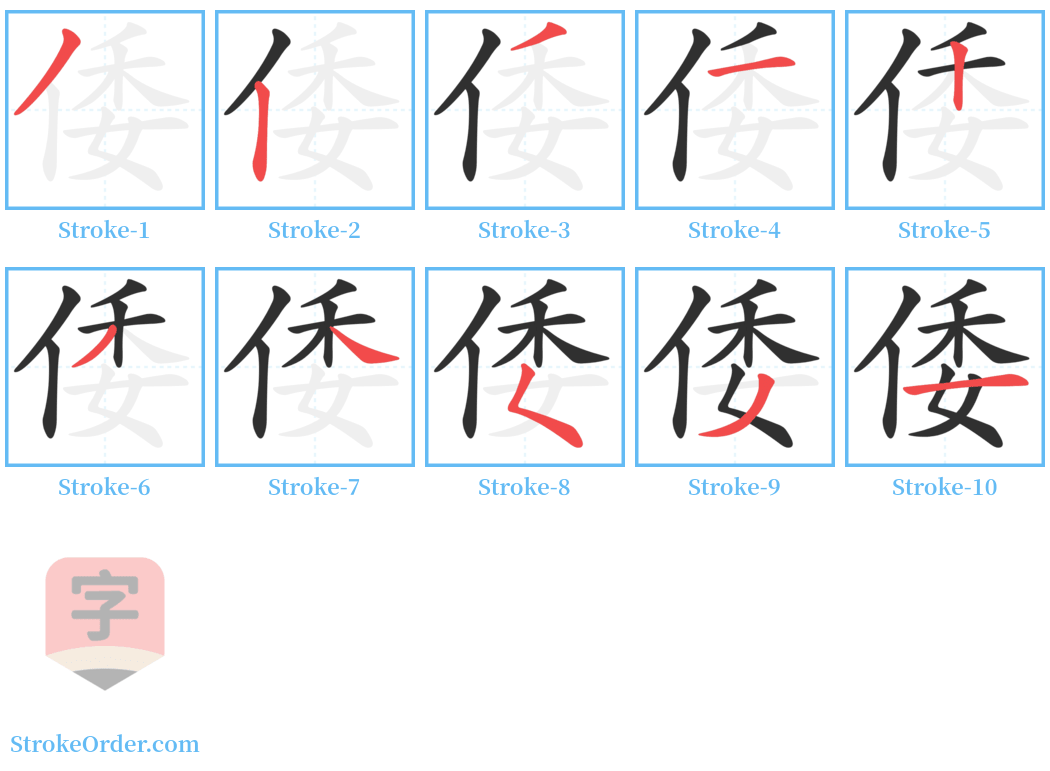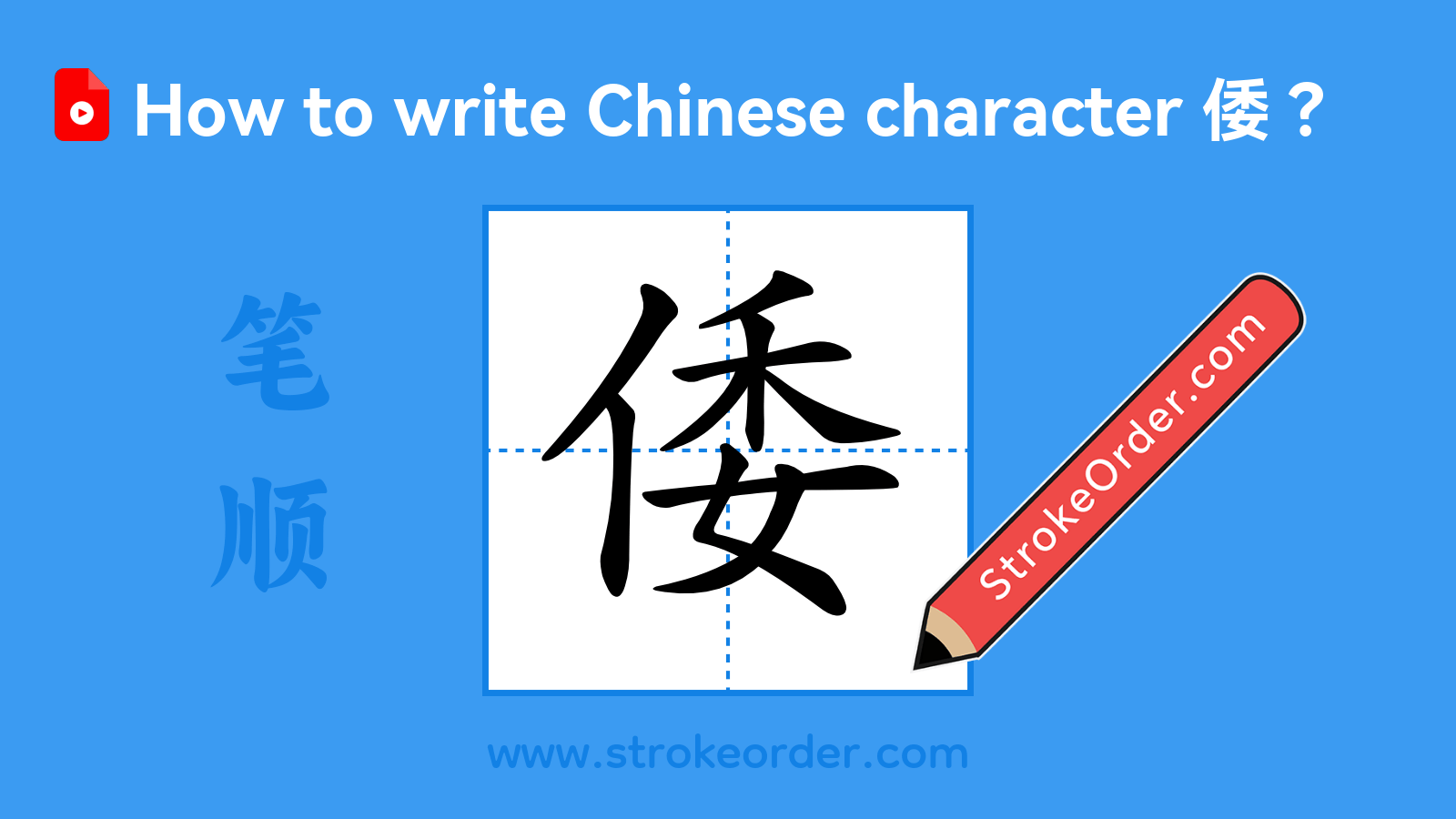倭 Stroke Order
Animated Stroke Order of 倭

Stroke Order Diagrams for 倭

Step-by-Step Handwriting Guide for 倭

Learn to Write Chinese Characters with Video Tutorials
Watch the video of writing the Chinese character "倭", learn the correct stroke order (笔顺) of the character "倭", and master the standard way of writing the character "倭".

Free Printable Handwriting Practice with Stroke Order: 倭
Printable Writing Practice Worksheet of "倭" in Portrait Orientation (Tian Zi Ge)

Printable Writing Practice Worksheet of "倭" in Landscape Orientation (Tian Zi Ge)

Information of 倭
Pinyinwō、 wēi
Radical
亻
Strokes
10 strokes
Usage
★★★★
Definition
Japanese / dwarf
倭 [wō] 1. In ancient times, Japan was referred to as "倭" during warfare. 2. In ancient times, Japan was referred to as "倭": 努 (slave), 寇 (bandit), 刀 (sword). 3. (Noun) A term for the Japanese people. In ancient China during the Han, Wei, Jin, and Southern and Northern Dynasties, Japan was known as "倭." Later, "倭" and "日本" (Japan) became commonly used (English: Japan). Examples include: 倭傀 (ancient ugly woman); 倭奴 (old term for Japanese—倭奴); 倭刀 (a sword made in Japan, known for its sharpness); 倭股 (Japanese-produced satin); 倭国 (ancient term for Japan in Chinese historical texts); 倭夷 (Japanese pirates). 4. (Noun) "倭堕": a hairstyle where the bun is tilted to one side. Reference from 君韻 [Jiyun]: "倭, 倭堕, hairstyle appearance." From 乐府文学 [Yuefu Poetry Collection]: "With a倭堕 bun on the head, and a moon pearl in the ear." 倭 [wō] 1. Short in stature (English: dwarf). Example: 倭狐猴 (dwarf lemur). 2. Short (English: short). Example: 倭刀 (short sword). 倭 [wō] 1. An ancient character meaning "逶," which refers to winding or meandering. For more information, see the entry on "倭迟." For further details, refer to the entry on "倭迟." 倭堕 [wō duò]: A hairstyle where the bun is slanted to one side. Reference from 君韻 [Jiyun]: "倭, 倭堕, hairstyle appearance." From 乐府文学 [Yuefu Poetry Collection]: "With a 倭堕 bun on the head, and a moon pearl in the ear."
Wo Nu
Anti-Japanese
(dialect) pumpkin
Japanese pirates (in 16th and 17th century)
Input Method for 倭
Pinyinwo1
Wubi
wtvg
Cangjie
ohdv
Zhengma
nmzm
Four Corner
22244
Unicode
U+502d
Same Pronunciation Characters
卧我握沃涡窝蜗倭喔幄挝斡渥肟莴龌撾渦硪窩臥蝸齷萵唩猧涹踒捰婐婑仴捾偓焥媉楃腛瞃瓁臒濣㠛㧴㱧㦱䁊䠎䰀
Same Radical Characters
亿什仁仅仆仇仍仔他仗付仙代仪们仰仲件价任份仿伊伍伏伐休优伙伟传伤伦伪伯估伴伶伸伺似佃但位低住佐佑体何佛作你佣佩佳使侄侈例侍供依侠侣侥
本文来自九江凉月投稿,不代表汉字笔顺中文网英文版立场,如若转载,请注明出处:https://www.strokeorder.cn/strokeorder/17392.html

 微信扫一扫
微信扫一扫 